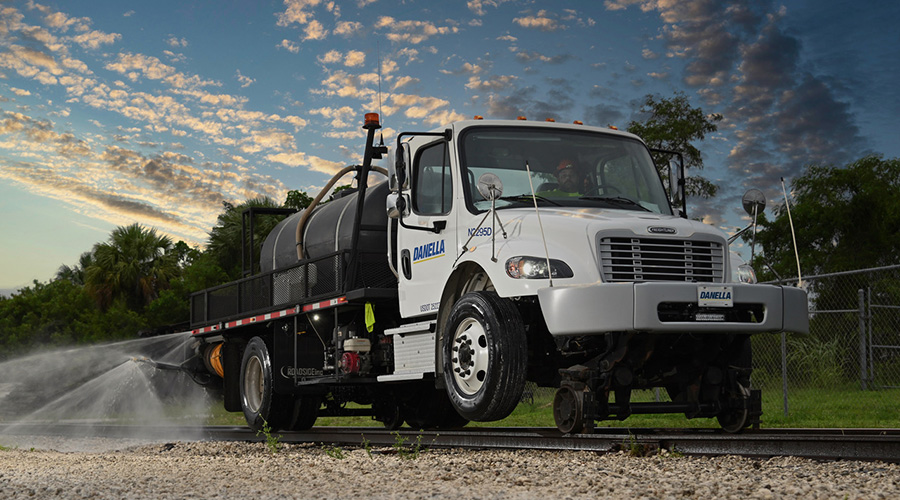Stay updated on news, articles and information for the rail industry
April 2008
Rail News: MOW
AAR Research Review — A technological link
Biting winds and temperatures in the upper 20s chased Transportation Technology Center Inc. (TTCI) visitors onto buses about an hour after a trackwalk event started at 8 a.m. on March 5. The Pueblo, Colo., research facility displayed more than 20 ongoing projects at the Facility for Accelerated Service Testing (FAST) high-tonnage loop during the 13th annual AAR Research Review’s second day. But many of the more than 200 in attendance were content to view research projects from the comfort of a heated bus instead of continuing to walk along the more than two-mile loop.
“This is some exciting stuff,” a bus-riding attendee said as he watched a trackside demonstration. Indeed.
The Association of American Railroads’ annual review of TTCI research touched on dozens of projects that hit railroaders’ main nerve: capacity. During the review’s first day on March 4 — a steady stream of presentations and panel discussions conducted at Pueblo’s convention center — TTCI President Roy Allen attributed record attendance (which surpassed 400) to the event’s theme: “Technology’s Role in Improving the Capacity of Railroads.”
“The 800-pound gorilla is capacity and we need to improve the role of technology in expanding capacity,” said Allen.
Railroads will need more assets and higher productivity to meet a projected 88 percent increase in freight-rail tonnage by 2035, said TTCI Vice President of Research Semih Kalay.
“You can improve productivity by using technology,” he said.
Attendees hailing from North American railroads and suppliers (BNSF, CSX, CPR, UP, Amtrak, MTA Metro-North, Amsted Rail and VAE Nortrak among them), and those abroad (including Brazil’s MRS and the United Kingdom’s Network Rail and Balfour Beatty Rail plc) listened intently as 13 TTCI engineers, investigators, scientists and researchers gave 16 presentations to highlight ongoing R&D.
First up, the development of a technology-driven train inspection (TDTI) system, which would examine a train online or as it enters a yard to decrease dwell times and reduce the risk of online setouts or derailments. TDTI would use data generated by truck hunting/performance, wheel impact load and other wayside detectors to certify car health, said TTCI researcher Jim Robeda. A task force comprising representatives from the Class Is, AAR, TTCI and RAILINC is developing a plan to address regulatory hurdles associated with TDTI.
Next came a presentation on an automated brake evaluation system installed in Belen, N.M., in conjunction with BNSF and monitoring system supplier LynxRail. Featuring brake-shoe imaging and thermal scanning capabilities, the system would “look at each car under brake application and determine if the brakes are effective or not,” said Robeda.
Under close inspection
After a review of several other systems, including those designed to automatically inspect truck castings or track, and detect imbalanced loads, and TTCI Senior Scientist Harry Tournay’s overview of more than a dozen existing or soon-to-be-developed detectors, Senior Engineer Randy Thompson described an automated wheel/rail contact inspection (WRCI) system. Designed to be installed on track geometry cars with automated measurement/assessment capabilities, WRCI would help reduce service failures associated with rail condition and slow orders tied to truck hunting, said Thompson. TTCI plans to implement WRCI on a BNSF geometry car in late 2008 or early 2009.
Later in the day, following a presentation on advanced rail steels and ties, Senior Engineer Dan Gutscher discussed improved rail welding techniques, including eletroslag welding for standard welds. Suitable for automation and non-rail consuming, eletroslag welds can reduce welding time by 10 percent and reduce per-weld costs compared with thermite welds, he said. TTCI plans to refine the process and begin FAST tests by July, then launch revenue service tests next year.
After 4 p.m., Principal Investigator Huimin Wu wrapped up the day with a look at managing rolling contact fatigue and rail wear. TTCI is developing wheel/rail interaction assessment tools, including the already available Wheel/Rail Tolerance (WRTOL™) and soon-to-be-created Wheel/Rail Interaction (WRIA™) software. This year, the center will continue to develop WRIA, which will determine dynamic wheel/rail interaction for specified operating conditions, said Wu.
All in all, TTCI is making technological strides that will play a key role in helping railroads accommodate growth, said Allen.
“Railroads need capacity, and that’s a good problem to have,” he said.
— Jeff Stagl


 2025 MOW Spending Report: Passenger-rail programs
2025 MOW Spending Report: Passenger-rail programs
 Gardner steps down as Amtrak CEO
Gardner steps down as Amtrak CEO
 Guest comment: Oliver Wyman’s David Hunt
Guest comment: Oliver Wyman’s David Hunt
 Women of Influence in Rail eBook
Women of Influence in Rail eBook
 railPrime
railPrime






